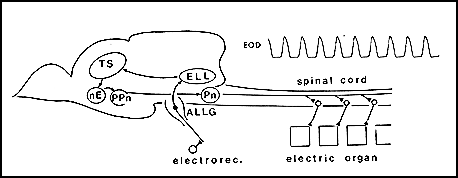
Glass knife fish, Eigenmannia virescens

Glass knife fish, Eigenmannia virescens
Weakly electric fish are able to sense objects in their surroundings by emitting weak (typically millivolt-level) electrical discharges and detecting perturbations in the self-generated electric field due to nearby objects in the water. This ability, referred to as electrolocation, allows weakly electric fish to hunt and navigate in the absence of visual cues at night or in turbid water.
Tree of Life: gymnotiformes
Among the many electrosensory-related behaviors observed in these fish, one of the best characterized from a neuroethological perspective is the jamming avoidance response (JAR). Certain weakly electric fish with sinusoidal, wave-type electric organ discharge (EOD) waveforms reflexively shift their EOD frequency away from interfering frequencies of nearby conspecifics, in order to avoid "jamming" each others electrical signals. This behavior allows multiple fish to operate in the same vicinity without interference, in analogy with multiple radio stations operating in the same city using different carrier frequencies. However, rather than relying on the FCC to regulate frequency assignments, weakly electric fish are able to sort things out for themselves using the jamming avoidance response.
When two wave-type weakly electric fish operate on similar frequencies, their object detection (electrolocation) capabilities are "jammed" due to the beat frequency generated as the two EOD waveforms go in and out of phase with each other. For example, consider two fish (A and B) with EOD frequencies of 300 and 304 Hz respectively.
BEFORE JAR
fA=300 Hz, fB=304 Hz
When these two fish come into the vicinity of one another, each will shift its frequency away from the interfering frequency, i.e. fish A will shift its frequency downward, while fish B will shift its frequency upward:
AFTER JAR
fA=292 Hz, fB=312 Hz
The original beat frequency of 4 Hz is detrimental to the fishs' electrolocation abilities, while the final beat frequency of 20 Hz is minimally disruptive (e.g. see Heiligenberg, 1973).
The neural circuitry that mediates the jamming avoidance response, and the signal processing functions carried out in each brain region, have been extremely well-characterized, from the sensory input to motor output. From a functional perspective, the nervous system needs to extract information from the electrosensory input to determine whether there is a jamming signal present, and if so whether the jamming signal is higher or lower in frequency.
Analyzing the beat frequency alone is not sufficient to tell the fish whether to shift its own frequency up or down, since the beat frequency corresponds to the absolute value of the frequency difference, i.e. a 4 Hz beat frequency would be generated whether the jamming signal was 4 Hz above or 4 Hz below the fish's own frequency. To determine which way to shift its own frequency, the fish has to analyze both amplitude and phase information contained in the beat cycle (for details see one of the reviews listed below). A summary diagram of the relevant circuitry is shown below.

Neural circuitry mediating the jamming avoidance response.
Abbreviations: ELL: electrosensory lateral line lobe (hindbrain) EOD electric organ discharge (spinal cord) nE: nucleus electrosensorius (diencephalon) PPn: prepacemaker nucleus (diencephalon) Pn: pacemaker nucleus (hindbrain) TS: torus semicircularis (midbrain)
Circuit summary:
electroreceptors: split the incoming sensory information into amplitude
and phase pathways.
ELL: maintains separation of amplitude and phase information and
enhances certain response features
TS: neurons in layer 6 compute differential phase; convergence of
amplitude and differential phase signals in deeper layers gives rise to
populations of "sign selective" cells that respond to positive
or negative difference frequencies (Df).
nE: contains higher order "sign selective" cells that respond
either to Df<0 or Df>0.
PPn: PPn neurons are excited by Df<0 neurons and inhibited by
Df>0 neurons; increased PPn activity increases the frequency of the Pn
oscillations and thus increases the EOD frequency.
Pn: contains electrotonically coupled pacemaker cells which fire
synchronously and drive the electric organ via spinal motor neurons.
EOD: the motor output; the electic organ discharge is driven by the
pacemaker nucleus.
Early classics:
Watanabe A and Takeda K (1963) The change of discharge frequency by A.C.
stimulus in a weakly electric fish. J Exp Biol 40:57-66.
Bullock TH, Hamstra RH, Scheich J (1972) The jamming avoidance response of high frequency electric fish, I & II. J Comp Physiol 77: 1-48.
Heiligenberg W (1973) Electrolocation of objects in the electric fish Eigenmannia (Rhamphichthyidae, Gymnotoidei). J Comp Physiol 87: 137-164.
Reviews:
Heiligenberg W (1986) Jamming Avoidance Responses: Model Systems for Neuroethology.
In: Electroreception, TH Bullock and W Heiligenberg, eds., Wiley,
pp. 613-649.
Heiligenberg W (1991) Neural Nets in Electric Fish. MIT Press.
Some Recent Advances:
Hagedorn M, Vischer HA, Heiligenberg W (1992) Development of the jamming
avoidance response and its morphological correlates in the Gymnotiform electric
fish Eigenmannia. J Neurobiol 23:1446-1466.
Metzner W (1993) The jamming avoidance response in Eigenmannia is controlled by two separate motor pathways. J Neurosci 13:1862-1878.
Kawasaki M (1993) Independently evolved jamming avoidance responses employ identical computational algorithms: a behavioral study of the African electric fish Gymnarchus niloticus. J Comp Physiol A 173: 9-22.
Rose GJ, Etter N, Alder TB (1994) Responses of electrosensory neurons in the torus semicircularis of Eigenmannia to complex beat stimuli: Testing hypotheses of temporal filtering. J Comp Physiol A 175:467-474.
